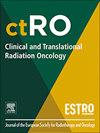Treatment time and learning curve analysis of 1.5 T MR-Linac workflows led by radiation oncologists or therapists
IF 2.7
3区 医学
Q3 ONCOLOGY
引用次数: 0
Abstract
Background and purpose
This study assessed the treatment time of online adaptive (i.e. Adapt-to-Shape, ATS) and virtual couch shift (i.e. Adapt-to-Position, ATP) magnetic resonance guided radiotherapy (MRgRT) on a 1.5 Tesla MR-Linac. Additionally, the transition from a radiation oncologists (RO)-led to a radiation therapist (RTT)-led workflow, and the presence of a learning curve were assessed.
Materials and methods
This study was conducted utilizing the prospective Multi-OutcoMe EvaluatioN of radiation Therapy Using the MR-Linac study (MOMENTUM, NCT04075305). Mean (±standard deviation) online adaptation time and total treatment time were collected from MR-Linac log files. Learning and proficiency phases were defined using a cumulative sum (CUSUM) analysis. Independent T-tests were performed. A p-value < 0.01 was considered statistically significant.
Results
In total, 4942 fractions of 645 patients were included. Mean total treatment time was 39 (±7), 15 (±2), 34 (±8), 41 (±11), and 40 (±7) minutes for ATS-treated prostate cancer, ATP-treated prostate cancer, ATS-treated pelvic lymph node metstasis (LNM), ATS-treated abdominal LNM and ATS-treated rectal cancer, respectively. Mean online adaptation time of RO-led and RTT-led treatment was 28 (±6) and 25 (±6) minutes (p < 0.001) for ATS-treated prostate cancer. No significant differences in the remaining subgroups were found. In subgroups with a learning curve, mean online adaptation time of learning and proficiency phase were 30 (±6) and 26 (±5) minutes (p < 0.001) for ATS-treated prostate cancer, 27 (±8) and 19 (±7) minutes for pelvic LNM (p < 0.001), and 29 (±7) and 25 (±7) minutes (p < 0.001) for rectal cancer, respectively.
Conclusion
The transition from RO-led to RTT-led workflows did not significantly increase total treatment time. The online adaptation time reduced after a learning curve for ATS-treated prostate cancer, pelvic LNM and rectal cancer.
Keywords; MRgRT, MR-Linac, time, prostate cancer, oligolymphnode metastasis, rectal cancer.
由放射肿瘤学家或治疗师领导的1.5 T MR-Linac工作流程的治疗时间和学习曲线分析。
背景与目的:本研究在1.5 Tesla MR-Linac上评估在线自适应(即ATS)和虚拟沙发移位(即ATP)磁共振引导放疗(MRgRT)的治疗时间。此外,评估了从放射肿瘤学家(RO)领导到放射治疗师(RTT)领导的工作流程的转变,以及学习曲线的存在。材料和方法:本研究采用MR-Linac研究(MOMENTUM, NCT04075305)对放射治疗进行前瞻性多结局评价。平均(±标准差)在线适应时间和总治疗时间从MR-Linac日志文件中收集。学习和熟练阶段使用累积和(CUSUM)分析来定义。进行独立t检验。A p值结果:共纳入645例患者的4942个部分。ats治疗前列腺癌、前列腺癌、盆腔淋巴结转移(LNM)、腹部淋巴结转移(LNM)和直肠癌的平均总治疗时间分别为39(±7)分钟、15(±2)分钟、34(±8)分钟、41(±11)分钟和40(±7)分钟。ro主导和rtt主导治疗的平均在线适应时间分别为28(±6)和25(±6)分钟(p)。结论:ro主导工作流程向rtt主导工作流程的过渡并未显著增加总治疗时间。ats治疗前列腺癌、盆腔淋巴结转移和直肠癌的在线适应时间缩短。MRgRT, MR-Linac,时间,前列腺癌,少淋巴结转移,直肠癌。
本文章由计算机程序翻译,如有差异,请以英文原文为准。
求助全文
约1分钟内获得全文
求助全文
来源期刊

Clinical and Translational Radiation Oncology
Medicine-Radiology, Nuclear Medicine and Imaging
CiteScore
5.30
自引率
3.20%
发文量
114
审稿时长
40 days
 求助内容:
求助内容: 应助结果提醒方式:
应助结果提醒方式:


